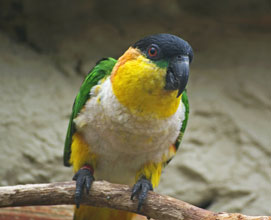
You can ask your veterinarian to trim your parrot’s wing feathers, but with a little practice, you can do it yourself. Get a fresh, clean towel and wrap around the bird. This will protect you in case it decides to fight back—and even the gentlest bird will. Then, hold its neck with your thumb and forefinger, a little below its head. Use your other hand to cradle its feet.
You will need to ask someone else to help you. He will pull one wing out of the towel and clip the feathers. A fast, but risky way is to cut off about 2/3 of its wing feathers in one go, using a sharp pair of scissors. Just avoid removing any new feathers, or you’ll draw blood. Many people prefer leaving the two outermost flight feathers, since it looks prettier and allows the bird more control when it tries to fly.
Most enthusiasts recommend clipping one feather at a time. This takes longer, but it’s safer, and lets you choose which ones to remove. You should just clip the ones just below the secondary feathers, which make up the outermost wing surface. You will need notched scissors, typically used for clipping the nails of cats or dogs.
Once you’re done, see if your bird can still fly by dropping him about two feet over your bed. If you’ve accidentally clipped a new feather (also called blood feather) then you have to pull it out completely, using pliers. This is unpleasant but necessary. Don’t put any styptic medicine on the feather or the skin, because it’ll cause a scar. (You should only use this on the beaks or nails.) Instead, just apply pressure on the wound, or take the bird to the vet, who will suture it with needle and thread.
You don’t really need to trim the beak unless there’s a medical problem (and even then, it’s best to leave this procedure to the vet). Caiques love to chew, which will wear down the beak the natural way. However, you will need to trim its nails. You can use the clippers for dog and cat nails, or short notched scissors. You can also invest in a wire cauterizer, which are sold by specialty pet stores. The electricity cauterizes the nails as it cuts, so you never have to worry about bleeding. Most enthusiasts, however, recommend just filing the nails with the same emery board you’d use on your own.